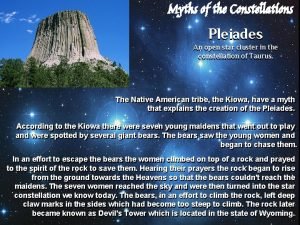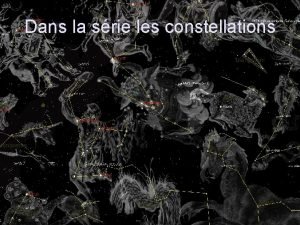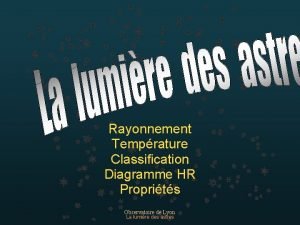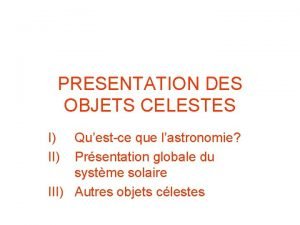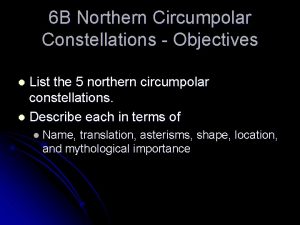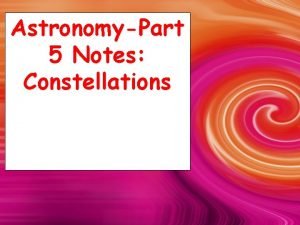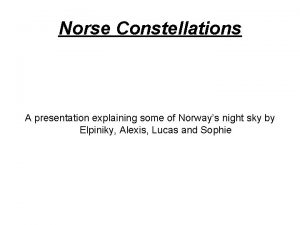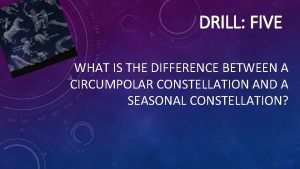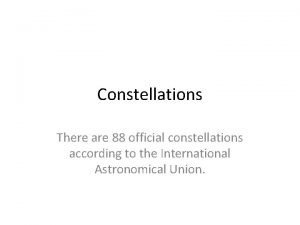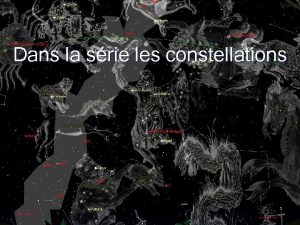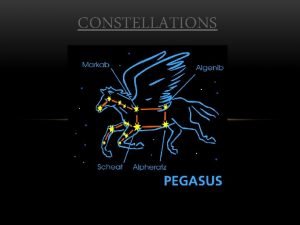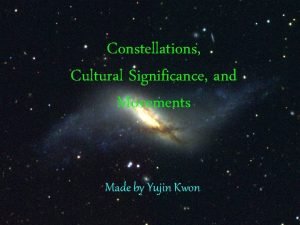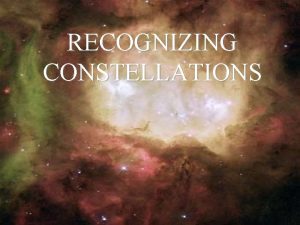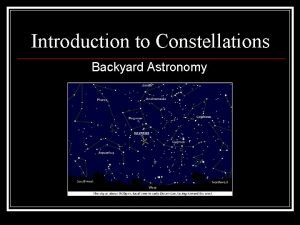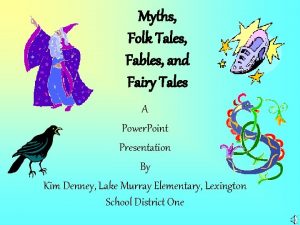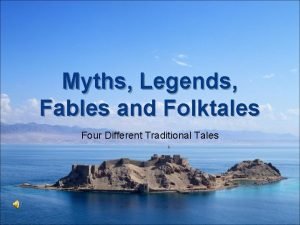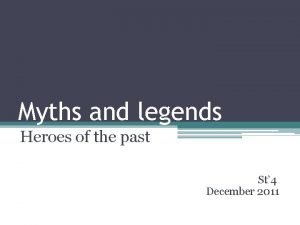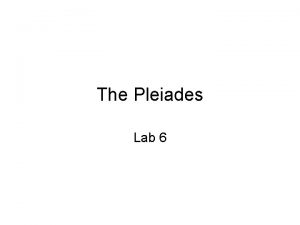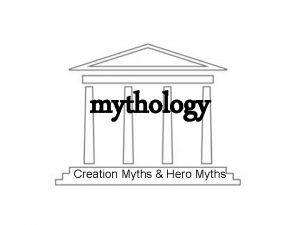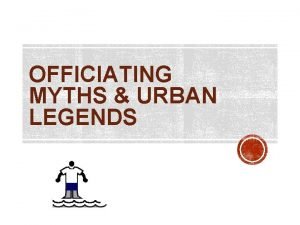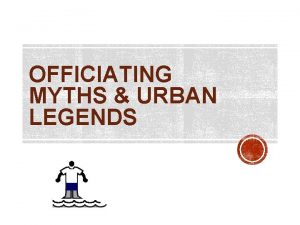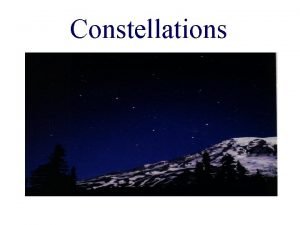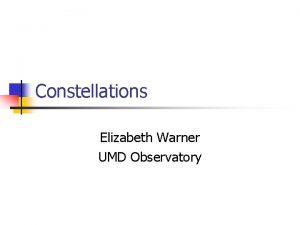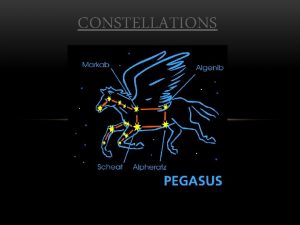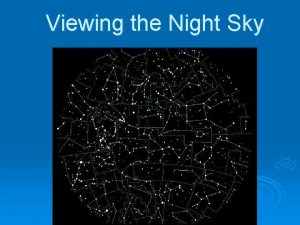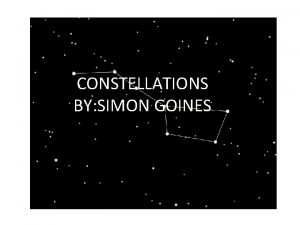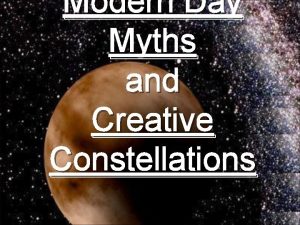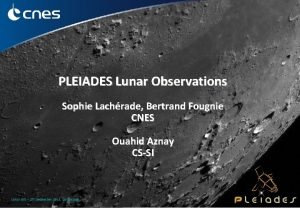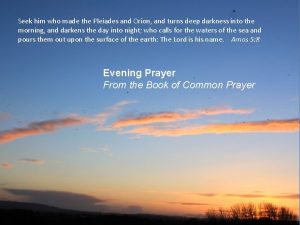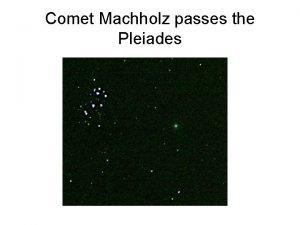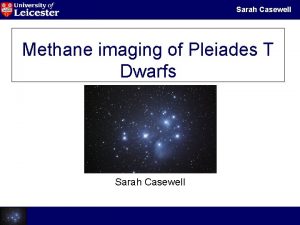Myths of the Constellations Pleiades An open star
























- Slides: 24

Myths of the Constellations Pleiades An open star cluster in the constellation of Taurus. The Native American tribe, the Kiowa, have a myth that explains the creation of the Pleiades. According to the Kiowa there were seven young maidens that went out to play and were spotted by several giant bears. The bears saw the young women and began to chase them. In an effort to escape the bears the women climbed on top of a rock and prayed to the spirit of the rock to save them. Hearing their prayers the rock began to rise from the ground towards the Heavens so that the bears couldn't reach the maidens. The seven women reached the sky and were then turned into the star constellation we know today. The bears, in an effort to climb the rock, left deep claw marks in the sides which had become too steep to climb. The rock later became known as Devil's Tower which is located in the state of Wyoming.

Small Solar Bodies Meteoroids Meteorites Asteroids Comets

Meteoroid The International Astronomical Union defines meteoroid as: "a solid object moving in interplanetary space, …smaller than an asteroid and…larger than an atom. "

Meteor A meteor is the visible streak of light that occurs when a meteoroid enters the Earth's atmosphere. While in space it is called a meteoroid. When it enters the atmosphere, impact pressure causes the body to heat up and emit light, thus forming a fireball, also known as a meteor or shooting star.

The upper air burst into life! And a hundred fire-flags sheen, To and fro they were hurried about! And to and fro, and in and out, The wan stars danced between And the coming wind did roar more loud, And the sails did sigh like sedge; And the rain poured down from one black cloud; The Moon was at its edge. “Rime of the Ancient Mariner” Samuel Taylor Coleridge From Wikipedia… “A meteor shower is a celestial event in which a number of meteors are observed to radiate, or originate, from one point in the night sky. These meteors are caused by streams of cosmic debris called meteoroids entering Earth's atmosphere at extremely high speeds on parallel trajectories. Most meteors are smaller than a grain of sand, so almost all of them disintegrate and never hit the Earth's surface. Intense or unusual meteor showers are known as meteor outbursts and meteor storms, which may produce greater than 1, 000 meteors an hour. ” Jenniskens, P. (2006). Meteor Showers and their Parent Comets. Cambridge University Press.

Meteorite A natural object originating in outer space that survives an impact with the Earth's surface. Photo of Peekskill meteorite taken by S. Eichmiller of the Altoona Mirror from Mansion Park football stadium A 12. 5 kg meteorite struck the back of Ms. Michelle Knapp's parked car on the evening of October 9, 1992 in Peekskill, NY. Ann Elizabeth Hodges was struck by a meteorite while inside her home in Sylacauga, Ala. in late 1954. (Jay Leviton/Time & Life Pictures/Getty Images)


Asteroids A piece of rock or metal made up of material similar to that which formed the planets. The giant asteroid Vesta, as imaged by the Dawn spacecraft, which studied Vesta from July 2011 to September 2012. The towering mountain at the south pole — more than twice the height of Mount Everest — is visible at the bottom of the image. The set of three craters known as the "snowman" can be seen at the top left. See more at: http: //dawn. jpl. nasa. gov/multimedia/full_view_vesta. asp#sthash. 64 r 5 t 9 BP. dpuf

Asteroids are mostly found in the asteroid belt, the region of the Solar System located roughly between the orbits of the planets Mars and Jupiter. The asteroid belt region is also termed the main belt to distinguish it from other concentrations of minor planets within the Solar System, such as the Kuiper belt and scattered disc.

Asteroid Vesta This topographic map from NASA's Dawn mission shows the two large impact basins in the southern hemisphere of the giant asteroid Vesta. The map is color-coded by elevation, with red showing the higher areas and blue showing the lower areas. Rheasilvia, the largest impact basin on Vesta, is 310 miles (500 kilometers) in diameter. Scientists estimate that it formed 1 billion years ago by counting the number of smaller craters that have formed on top of it. The other basin, Veneneia, is 250 miles (400 kilometers) across and lies partially beneath Rheasilvia. Scientists estimate that Veneneia is at least 2 billion years old. http: //dawn. jpl. nasa. gov/multimedia/south_polar_impacts. asp#sthash. Eaonku. BI. dpuf

Impacts Barringer Meteor Crater in Arizona Formed when ~ 50 ft diameter nickel-iron meteorite slammed into the Earth. 3900 ft in diameter, 570 ft deep Rim rises 145 ft above surrounding plains

Comets Commonly called a “dirty snowball”, a comet is made of dust and rock particles mixed with frozen water, methane, and ammonia. Comet Hale-Bopp

Structure of a Comet As a comet approaches the Sun, the ices of water, methane, and ammonia vaporize because of the heat from the Sun, releasing gas, dust and bits of rock. This material forms a bright cloud around the nucleus called the coma. Some of the material is swept away from the comet by the solar wind, producing the comet’s tail.

Comets Comet Hale-Bopp (below) as an example of a typical comet. A comet is commonly described as having 3 parts: Nucleus – the dark dirty snowball composed of ice, dirt, rock and gas Coma – the halo of gas, ice and rock bursting forth from the nucleus Tail – may include both the dust and ion tail

Comets The various parts of a comet can be quite large, as illustrated here.

Comets have unique long, narrow elliptical orbits around the Sun.

Close Encounter With a Comet This image was one of many taken by the Stardust spacecraft (shown below) as it flew past Comet Wild 2 on January 2, 2004. The image was taken at a distance of approximately 500 km (311 miles) and shows Wild 2's nucleus, which is thought to be about 4 kilometers (2. 5 miles) in diameter. http: //curious. astro. cornell. edu/comets. php Comet Wild 2 (pronounced ‘Vild’) Credit: NASA, JPL

Riding a Comet : The Rosetta Mission

https: //www. youtube. com/watch? v=4 rqm. OC 6 M-ro

Comet A relatively small, at times active, object whose ices can vaporize in sunlight forming an atmosphere (coma) of dust and gas and, sometimes, a tail of dust and/or gas. Asteroid A relatively small, inactive, rocky body orbiting the Sun. A small particle from a Meteoroid comet or asteroid orbiting the Sun. Meteor The light phenomena which results when a meteoroid enters the Earth's atmosphere and vaporizes; a shooting star. A meteoroid that survives its passage Meteorite through the Earth's atmosphere and lands upon the Earth's surface.

Small Solar Bodies Poster Make a poster illustrating comets, meteoroids, meteors, meteorites, and asteroids. Foldable will be graded as follows: Comets - 3 main parts (define, illustrate & describe orbit) 15 pts Meteors (define & illustrate) 15 pts Meteoroids (define & illustrate) 15 pts Meteorites (define & illustrate) 15 pts Asteroids (define & illustrate) 15 pts Neatness (written in pen; -5 for pencil) 10 pts MLA Heading on back 5 pts Spelling (-1 per mistake) 5 pts Colored 5 pts Total Points Possible = 100



Riding a Comet : The Rosetta Mission During a circuitous ten-year trek across the Solar System, Rosetta will cross the asteroid belt and travel into deep space, more than five times Earth’s distance from the Sun. Its destination will be a periodic comet known as Comet 67 P/Churyumov-Gerasimenko. The Rosetta orbiter will rendezvous with Comet 67 P/Churyumov-Gerasimenko and remain in close proximity to the icy nucleus as it plunges towards the warmer inner reaches of the Sun’s domain. At the same time, a small lander will be released onto the surface of this mysterious cosmic iceberg. More than a year will pass before the remarkable mission draws to a close in December 2015. By then, both the spacecraft and the comet will have circled the Sun and be on their way out of the inner Solar System. http: //www. esa. int/Our_Activities/Space_Science/Rosetta
 Star of wonder star of night star of royal beauty bright
Star of wonder star of night star of royal beauty bright Myths about comets
Myths about comets Les pléiades mythologie
Les pléiades mythologie Les pleiades
Les pleiades Les pleiades
Les pleiades Open innovation open science open to the world
Open innovation open science open to the world Cetus constellation myth
Cetus constellation myth Constellations
Constellations Constellations defintion
Constellations defintion Norse constellations
Norse constellations Five circumpolar constellations
Five circumpolar constellations Findpkjobs.com
Findpkjobs.com 88 official constellations
88 official constellations Les constellations les plus connues
Les constellations les plus connues What are constellations
What are constellations Are constellations capitalized
Are constellations capitalized Yujin constellations
Yujin constellations Pretestp
Pretestp Year round constellations
Year round constellations Aquarius water bearer meaning
Aquarius water bearer meaning Ao* algorithm in artificial intelligence
Ao* algorithm in artificial intelligence What does star in star events stand for?
What does star in star events stand for? Example of folktales
Example of folktales Legends and myths difference
Legends and myths difference Facts about king midas
Facts about king midas

